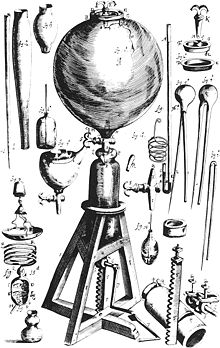
An air pump is a pump for pushing air. Examples include a bicycle pump, pumps that are used to aerate an aquarium or a pond via an airstone; a gas compressor used to power a pneumatic tool, air horn or pipe organ; a bellows used to encourage a fire; a vacuum cleaner and a vacuum pump. All air pumps contain a part that moves (vane, piston, impeller, diaphragm etc.) which drives the flow of air. When the air gets moved, an area of low pressure gets created which fills up with more air.[1]
Pumps and compressors use very similar mechanisms, and basically perform the same action, but in different fluid regimes. At some point there is a crossover point in terminology, but here are some stereotypes:
- Compressors operate on compressible fluids, typically gases. Pumps operate on fluids, typically liquids, approximated as in-compressible.
- Compressors are intended to develop a very high pressure rise against a closed system; pumps are designed to develop relatively little pressure against a free-flowing system with minimal back-pressure.
- Pumps are often used in continuous-flow operation, while many lower-end compressors must have intermittent duty cycles.
- Compressors usually have a feedback sensor to shut off when they reach a desired pressure; pumps have a fixed design and operate freely across their performance curve as conditions change
- ^ "Pump Theory – Principles". powerequipment.honda.com. Archived from the original on 26 November 2018. Retrieved 26 November 2018.